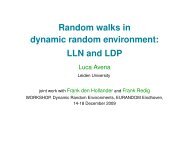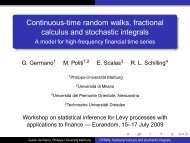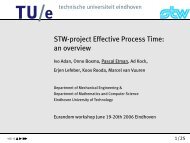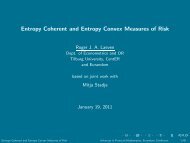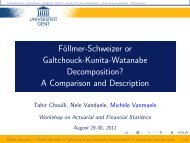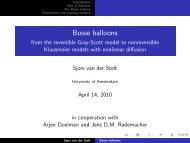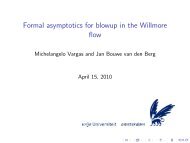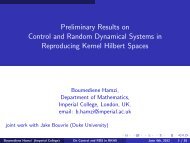presentation - Eurandom
presentation - Eurandom
presentation - Eurandom
Create successful ePaper yourself
Turn your PDF publications into a flip-book with our unique Google optimized e-Paper software.
Recent results on volatility change point estimation<br />
for stochastic differential equations<br />
Stefano M. Iacus (University of Milan & Core Team)<br />
Workshop on Parameter Estimation for Dynamical Systems, <strong>Eurandom</strong>, 4-6 June 2012<br />
S.M. Iacus 2012 PEDS2 <strong>Eurandom</strong> – 1 / 95
The change point<br />
problem<br />
Historical remarks<br />
Diffusion processes<br />
General Itô processes<br />
YUIMA R Package<br />
The change point problem<br />
S.M. Iacus 2012 PEDS2 <strong>Eurandom</strong> – 2 / 95
The change point<br />
problem<br />
Historical remarks<br />
Diffusion processes<br />
General Itô processes<br />
YUIMA R Package<br />
Change point problem<br />
Discover from the data a structural change in the generating model.<br />
S.M. Iacus 2012 PEDS2 <strong>Eurandom</strong> – 3 / 95
The change point<br />
problem<br />
Historical remarks<br />
Diffusion processes<br />
General Itô processes<br />
YUIMA R Package<br />
Change point problem<br />
Discover from the data a structural change in the generating model.<br />
Next example shows historical change points for the Dow-Jones index.<br />
S.M. Iacus 2012 PEDS2 <strong>Eurandom</strong> – 3 / 95
The change point<br />
problem<br />
Historical remarks<br />
Diffusion processes<br />
General Itô processes<br />
YUIMA R Package<br />
Change point problem<br />
Discover from the data a structural change in the generating model.<br />
Next example shows historical change points for the Dow-Jones index.<br />
750 850 950 1050<br />
-0.06 0.00 0.04<br />
Dow-Jones closings<br />
1972 1973 1974<br />
Dow-Jones returns<br />
1972 1973 1974<br />
break of gold-US$ linkage (left) Watergate scandal (right)<br />
S.M. Iacus 2012 PEDS2 <strong>Eurandom</strong> – 3 / 95
The change point<br />
problem<br />
Historical remarks<br />
The i.i.d. case and time<br />
series<br />
Diffusion processes<br />
General Itô processes<br />
YUIMA R Package<br />
Historical remarks<br />
S.M. Iacus 2012 PEDS2 <strong>Eurandom</strong> – 4 / 95
The change point<br />
problem<br />
Historical remarks<br />
The i.i.d. case and time<br />
series<br />
Diffusion processes<br />
General Itô processes<br />
YUIMA R Package<br />
The i.i.d. case and time series<br />
Originally, the problem was considered for i.i.d samples; see Hinkley<br />
(1971), Csörgő and Horváth (1997), Inclan and Tiao (1994)<br />
S.M. Iacus 2012 PEDS2 <strong>Eurandom</strong> – 5 / 95
The change point<br />
problem<br />
Historical remarks<br />
The i.i.d. case and time<br />
series<br />
Diffusion processes<br />
General Itô processes<br />
YUIMA R Package<br />
The i.i.d. case and time series<br />
Originally, the problem was considered for i.i.d samples; see Hinkley<br />
(1971), Csörgő and Horváth (1997), Inclan and Tiao (1994)<br />
It moved quickly to time series analysis: Bai (1994, 1997), Kim et al.<br />
(2000), Lee et al. (2003), Chen et al. (2005) and the papers cited therein.<br />
S.M. Iacus 2012 PEDS2 <strong>Eurandom</strong> – 5 / 95
The change point<br />
problem<br />
Historical remarks<br />
The i.i.d. case and time<br />
series<br />
Diffusion processes<br />
General Itô processes<br />
YUIMA R Package<br />
The i.i.d. case and time series<br />
Originally, the problem was considered for i.i.d samples; see Hinkley<br />
(1971), Csörgő and Horváth (1997), Inclan and Tiao (1994)<br />
It moved quickly to time series analysis: Bai (1994, 1997), Kim et al.<br />
(2000), Lee et al. (2003), Chen et al. (2005) and the papers cited therein.<br />
The list is vastly incomplete.<br />
Main approaches: least squares, MLE, Bayesian and CUSUM<br />
S.M. Iacus 2012 PEDS2 <strong>Eurandom</strong> – 5 / 95
The change point<br />
problem<br />
Historical remarks<br />
Diffusion processes<br />
Continuous time obs.<br />
Discrete sampling<br />
Least Squares<br />
CUSUM<br />
General Itô processes<br />
YUIMA R Package<br />
Diffusion processes<br />
S.M. Iacus 2012 PEDS2 <strong>Eurandom</strong> – 6 / 95
The change point<br />
problem<br />
Historical remarks<br />
Diffusion processes<br />
Continuous time obs.<br />
Discrete sampling<br />
Least Squares<br />
CUSUM<br />
General Itô processes<br />
YUIMA R Package<br />
Change point for diffusion processes<br />
For continuous time observations, Kutoyants (1994, 2004) considered<br />
change point (in space) problem for the drift of an ergodic diffusion<br />
process solution to<br />
dXt = S(θ, Xt)dt + σ(Xt)dWt, X0, t ≥ 0 (1)<br />
with the trend function discontinuous along the two points of the state<br />
space of Xt, say x (1)<br />
∗ (θ) and x (2)<br />
∗ (θ), θ ∈ [α, β] ⊂ R and the interest is in<br />
the estimation of θ.<br />
Lee, Nishiyama and Yoshida (2003) considered CUSUM tests statistic for<br />
the time change point for the model in (1) where θ takes different values<br />
before and after a time instant τ ∗ .<br />
Habibi R. (2012) considered a recursive-MLE approach for the estimation<br />
of the change point in the parameter of the drift from 1-d continuous time<br />
observations in the very special case of gBm with stochastic volatility:<br />
dXt = θXtdt + σtXtdWt.<br />
S.M. Iacus 2012 PEDS2 <strong>Eurandom</strong> – 7 / 95
The change point<br />
problem<br />
Historical remarks<br />
Diffusion processes<br />
Continuous time obs.<br />
Discrete sampling<br />
Least Squares<br />
CUSUM<br />
General Itô processes<br />
YUIMA R Package<br />
Estimation of volatility under discrete time sampling<br />
The problem of parametric estimation of the volatility (and drift) for<br />
discretely observed diffusion processes under different sampling schemes,<br />
dates back to the works of Genon-Catalot and Jacod (1993, 1994),<br />
Yoshida (1992) and Kessler (1997).<br />
Change point analysis for the volatility appears in the few works reviewed<br />
in the following.<br />
The main peculiarity is the non regularity of the statistical model with<br />
respect to the structural change, i.e. the (quasi-)likelihood is not smooth<br />
with respect to the parameter τ, the change point instant. This fact add<br />
some technicalities in the proofs and different limiting distributions are<br />
obtained and rates of convergence are faster than usual √ n.<br />
S.M. Iacus 2012 PEDS2 <strong>Eurandom</strong> – 8 / 95
The change point<br />
problem<br />
Historical remarks<br />
Diffusion processes<br />
Continuous time obs.<br />
Discrete sampling<br />
Least Squares<br />
CUSUM<br />
General Itô processes<br />
YUIMA R Package<br />
Least squares approach<br />
De Gregorio and I. (2008) considered the change point problem for the<br />
ergodic model<br />
dXt = b(Xt)dt + √ θσ(Xt)dWt, 0 ≤ t ≤ T,X0 = x0,<br />
observed at discrete time instants ti = i∆n, i =0,...,n, ∆n = ti+1 − ti<br />
under the sampling scheme ∆n → 0, n →∞, n∆n = T , T fixed. The<br />
coefficients b and σ are supposed to be known. The change point problem<br />
is formulated as follows<br />
Xt =<br />
<br />
X0 + t<br />
0 b(Xs)ds + √ θ1<br />
S.M. Iacus 2012 PEDS2 <strong>Eurandom</strong> – 9 / 95<br />
t<br />
Xτ ∗ + t<br />
τ ∗ b(Xs)ds + √ θ2<br />
0 σ(Xs)dWs, 0 ≤ t ≤ τ ∗<br />
t<br />
τ ∗ σ(Xs)dWs, τ ∗
The change point<br />
problem<br />
Historical remarks<br />
Diffusion processes<br />
Continuous time obs.<br />
Discrete sampling<br />
Least Squares<br />
CUSUM<br />
General Itô processes<br />
YUIMA R Package<br />
i=1<br />
Least squares approach<br />
Let Zi = Xi+1−Xi−b(Xi)∆n<br />
√ be the standardized residuals. Let<br />
∆nσ(Xi)<br />
k0 =[n · τ ∗ ], then the LS estimator is obtained via<br />
ˆk0 =<br />
<br />
k<br />
argmin min (Z<br />
k θ1,θ2<br />
i=1<br />
2 i − θ1) 2 n<br />
+ (Z<br />
i=k+1<br />
2 i − θ2) 2<br />
=<br />
<br />
<br />
k<br />
argmin (Z<br />
k<br />
2 i − ¯ θ1) 2 n<br />
+ (Z 2 i − ¯ θ2) 2<br />
<br />
, (2)<br />
where<br />
¯θ1 = 1<br />
k<br />
k<br />
i=1<br />
Z 2 i =: Sk<br />
k<br />
i=k+1<br />
and ¯ θ2 = 1<br />
n − k<br />
S.M. Iacus 2012 PEDS2 <strong>Eurandom</strong> – 10 / 95<br />
n<br />
i=k+1<br />
Z 2 i =: S∗ n−k<br />
n − k .
The change point<br />
problem<br />
Historical remarks<br />
Diffusion processes<br />
Continuous time obs.<br />
Discrete sampling<br />
Least Squares<br />
CUSUM<br />
General Itô processes<br />
YUIMA R Package<br />
Solving (2) is equivalent to solve the following<br />
Dk = k<br />
n<br />
Least squares approach<br />
Sk<br />
− .<br />
Sn<br />
Therefore, least squares change point estimator ˆ k0 (ˆτn = ˆ k0/n)isgiven<br />
by<br />
ˆk0 =argmax|Dk|<br />
k<br />
Theorem: Under H0 : θ1 = θ2, i.e. “no change point”, we have that<br />
<br />
n<br />
2 |Dk| d →|B0(τ)|, B0(τ) Brownian bridge on [0, 1]<br />
The estimator ˆτn is consistent.<br />
S.M. Iacus 2012 PEDS2 <strong>Eurandom</strong> – 11 / 95
The change point<br />
problem<br />
Historical remarks<br />
Diffusion processes<br />
Continuous time obs.<br />
Discrete sampling<br />
Least Squares<br />
CUSUM<br />
General Itô processes<br />
YUIMA R Package<br />
Let ϑn = |θ2 − θ1|. Under the conditions<br />
ϑn → 0,<br />
nϑ 2 n(ˆτn − τ ∗ )<br />
2 ˆ θ 2<br />
Under contiguous alternatives<br />
√ nϑn<br />
√ log n →∞,<br />
<br />
d<br />
→ arg max W(v) −<br />
v<br />
|v|<br />
<br />
2<br />
with ˆ θ some consistent estimator of the common limit θ0 of θ1 and θ2; W<br />
is a two sided Brownian motion, i.e.<br />
<br />
W1(−u), u < 0<br />
W(u) =<br />
(3)<br />
W2(u), u ≥ 0<br />
where W1,W2 are two independent Brownian motions.<br />
S.M. Iacus 2012 PEDS2 <strong>Eurandom</strong> – 12 / 95
The change point<br />
problem<br />
Historical remarks<br />
Diffusion processes<br />
Continuous time obs.<br />
Discrete sampling<br />
Least Squares<br />
CUSUM<br />
General Itô processes<br />
YUIMA R Package<br />
The estimators ˆ θ1, ˆ θ2 are also well behaved, i.e.<br />
<br />
√ ˆθ1 − θ1<br />
n<br />
ˆθ2 − θ2<br />
Under contiguous alternatives<br />
d→ N (0, Σ) , where Σ=<br />
S.M. Iacus 2012 PEDS2 <strong>Eurandom</strong> – 13 / 95<br />
<br />
2 θ2 0<br />
τ ∗ 0<br />
0 2 θ2 0<br />
1−τ ∗<br />
The above results hold in the high frequency case ∆n → 0 with n →∞<br />
and n∆ =T fixed, but also for the rapidly increasing design case<br />
n∆n = T →∞.<br />
<br />
.
The change point<br />
problem<br />
Historical remarks<br />
Diffusion processes<br />
Continuous time obs.<br />
Discrete sampling<br />
Least Squares<br />
CUSUM<br />
General Itô processes<br />
YUIMA R Package<br />
Case of unknown drift<br />
We assume now to observe a diffusion process that is a solution to the<br />
reduced stochastic differential equation<br />
dXt = b(Xt)dt + √ θdWt,<br />
where b(·) is unknown and estimated using nonparametric methods. Let<br />
K be a suitable kernel, and consider the estimator<br />
ˆ b(x) =<br />
Xi−x<br />
n i=1 K<br />
n i=1 K<br />
S.M. Iacus 2012 PEDS2 <strong>Eurandom</strong> – 14 / 95<br />
hn<br />
Xi+1−Xi<br />
Xi−x<br />
the above is a particular case of the nonparametric estimators of the drift<br />
considered in Bandi and Phillips (2003), but other approaches exist.<br />
For fixed T , the drift b(·) cannot be estimated consistently, hence it is<br />
required that T →∞.<br />
hn<br />
∆n
The change point<br />
problem<br />
Historical remarks<br />
Diffusion processes<br />
Continuous time obs.<br />
Discrete sampling<br />
Least Squares<br />
CUSUM<br />
General Itô processes<br />
YUIMA R Package<br />
Let<br />
¯LX(t, x) = lim<br />
ɛ→0<br />
Bandwidth hn and local time<br />
S.M. Iacus 2012 PEDS2 <strong>Eurandom</strong> – 15 / 95<br />
1<br />
2ɛ<br />
t<br />
0<br />
1 {x,x+ɛ}(Xs)ds<br />
be the the chronological local time of X. Bandi and Phillips (2003) shown<br />
that under the following additional assumption<br />
<br />
¯LX(T,x)<br />
<br />
1<br />
∆n log = oa.s.(1)<br />
hn<br />
and hn ¯ LX(T,x) a.s.<br />
→∞, ˆb(·) is a consistent estimator of b(·). In the<br />
stationary case, the above condition may be replaced by<br />
<br />
T<br />
1<br />
∆n log = oa.s.(1).<br />
hn<br />
∆n<br />
∆n
The change point<br />
problem<br />
Historical remarks<br />
Diffusion processes<br />
Continuous time obs.<br />
Discrete sampling<br />
Least Squares<br />
CUSUM<br />
General Itô processes<br />
YUIMA R Package<br />
Pluggin-in the standardized residuals<br />
ˆZi = Xi+1 − Xi − ˆ b(Xi)∆n<br />
√ ∆n<br />
into the statistic Dk, all previous results hold.<br />
Case of unknown drift<br />
This approach has been used in Smaldone (2009) to re-analyze the recent<br />
global financial crisis using data from different markets. It emerged that<br />
the analysis of some of the assets could have predict by the last week of<br />
June 2008 the global structural change of late september 2008.<br />
S.M. Iacus 2012 PEDS2 <strong>Eurandom</strong> – 16 / 95
June 30<br />
July 4<br />
Lehman<br />
Brothers<br />
July 7<br />
July 11<br />
July 14<br />
July18<br />
DJ Stoxx America 600 Banks<br />
DJ DJ Stoxx 600 Banks<br />
Deutsche Bank<br />
HBSC<br />
Barclays<br />
Deutsche Bank (GER)<br />
CAC<br />
DJ Stoxx Global<br />
1800 Banks<br />
August 18<br />
August 22<br />
S&P MIB<br />
Nikkei 225<br />
August 25<br />
August 29<br />
FTSE<br />
DJ Stoxx 600<br />
Time<br />
Sept. 1<br />
Sept. 5<br />
Lehman<br />
Brothers<br />
Sept. 8<br />
Sept. 12<br />
DJ Stoxx<br />
600 Banks<br />
Sept. 15<br />
Sept. 19<br />
Goldman<br />
Sachs<br />
Sept. 22<br />
Sept. 26<br />
Sept. 29<br />
Oct. 3<br />
Oct. 6<br />
Oct. 10<br />
Deutsche Bank<br />
HSBC Nasdaq<br />
Nyse<br />
Dow Jones<br />
S&P 500<br />
FTSE<br />
DAX<br />
S&P MIB<br />
CAC<br />
IBEX<br />
SMI<br />
Nikkei 225<br />
DJ Stoxx 600 Banks<br />
DJ Stoxx Global 1800<br />
MCSI World<br />
Morgan Stanley<br />
Bank of America<br />
Barclays<br />
RBS<br />
Unicredit<br />
Intesa Sanpaolo<br />
Deutsche Bank (GER)<br />
Commerzbank<br />
Oct. 20<br />
Oct 24<br />
Dj Stoxx Asia Pacific<br />
600 Banks<br />
JP Morgan Chase
8000 9000 10000 11000 12000 13000<br />
−0.20 −0.15 −0.10 −0.05 0.00 0.05 0.10<br />
Financial crisis 2008 - Real time analysis<br />
Dow Jones Jan08−Jan09<br />
Jan Mar May Jul Sep Nov Jan<br />
weekly returns<br />
Jan Mar May Jul Sep Nov Jan<br />
S.M. Iacus 2012 PEDS2 <strong>Eurandom</strong> – 18 / 95
8000 9000 10000 11000 12000 13000<br />
−0.20 −0.15 −0.10 −0.05 0.00 0.05 0.10<br />
Financial crisis 2008 - Real time analysis<br />
Dow Jones Jan08−Jan09<br />
Jan Mar May Jul Sep Nov Jan<br />
weekly returns<br />
Jan Mar May Jul Sep Nov Jan<br />
S.M. Iacus 2012 PEDS2 <strong>Eurandom</strong> – 19 / 95
8000 9000 10000 11000 12000 13000<br />
−0.20 −0.15 −0.10 −0.05 0.00 0.05 0.10<br />
Financial crisis 2008 - Real time analysis<br />
Dow Jones Jan08−Jan09<br />
Jan Mar May Jul Sep Nov Jan<br />
weekly returns<br />
Jan Mar May Jul Sep Nov Jan<br />
S.M. Iacus 2012 PEDS2 <strong>Eurandom</strong> – 20 / 95
8000 9000 10000 11000 12000 13000<br />
−0.20 −0.15 −0.10 −0.05 0.00 0.05 0.10<br />
Financial crisis 2008 - Real time analysis<br />
Dow Jones Jan08−Jan09<br />
Jan Mar May Jul Sep Nov Jan<br />
weekly returns<br />
Jan Mar May Jul Sep Nov Jan<br />
S.M. Iacus 2012 PEDS2 <strong>Eurandom</strong> – 21 / 95
8000 9000 10000 11000 12000 13000<br />
−0.20 −0.15 −0.10 −0.05 0.00 0.05 0.10<br />
Financial crisis 2008 - Real time analysis<br />
Dow Jones Jan08−Jan09<br />
Jan Mar May Jul Sep Nov Jan<br />
weekly returns<br />
Jan Mar May Jul Sep Nov Jan<br />
S.M. Iacus 2012 PEDS2 <strong>Eurandom</strong> – 22 / 95
8000 9000 10000 11000 12000 13000<br />
−0.20 −0.15 −0.10 −0.05 0.00 0.05 0.10<br />
Financial crisis 2008 - Real time analysis<br />
Dow Jones Jan08−Jan09<br />
Jan Mar May Jul Sep Nov Jan<br />
weekly returns<br />
Jan Mar May Jul Sep Nov Jan<br />
S.M. Iacus 2012 PEDS2 <strong>Eurandom</strong> – 23 / 95
8000 9000 10000 11000 12000 13000<br />
−0.20 −0.15 −0.10 −0.05 0.00 0.05 0.10<br />
Financial crisis 2008 - Real time analysis<br />
Dow Jones Jan08−Jan09<br />
Jan Mar May Jul Sep Nov Jan<br />
weekly returns<br />
Jan Mar May Jul Sep Nov Jan<br />
S.M. Iacus 2012 PEDS2 <strong>Eurandom</strong> – 24 / 95
8000 9000 10000 11000 12000 13000<br />
−0.20 −0.15 −0.10 −0.05 0.00 0.05 0.10<br />
Financial crisis 2008 - Real time analysis<br />
Dow Jones Jan08−Jan09<br />
Jan Mar May Jul Sep Nov Jan<br />
weekly returns<br />
Jan Mar May Jul Sep Nov Jan<br />
S.M. Iacus 2012 PEDS2 <strong>Eurandom</strong> – 25 / 95
8000 9000 10000 11000 12000 13000<br />
−0.20 −0.15 −0.10 −0.05 0.00 0.05 0.10<br />
Financial crisis 2008 - Real time analysis<br />
Dow Jones Jan08−Jan09<br />
Jan Mar May Jul Sep Nov Jan<br />
weekly returns<br />
Jan Mar May Jul Sep Nov Jan<br />
S.M. Iacus 2012 PEDS2 <strong>Eurandom</strong> – 26 / 95
8000 9000 10000 11000 12000 13000<br />
−0.20 −0.15 −0.10 −0.05 0.00 0.05 0.10<br />
Financial crisis 2008 - Real time analysis<br />
Dow Jones Jan08−Jan09<br />
Jan Mar May Jul Sep Nov Jan<br />
weekly returns<br />
Jan Mar May Jul Sep Nov Jan<br />
S.M. Iacus 2012 PEDS2 <strong>Eurandom</strong> – 27 / 95
8000 9000 10000 11000 12000 13000<br />
−0.20 −0.15 −0.10 −0.05 0.00 0.05 0.10<br />
Financial crisis 2008 - Real time analysis<br />
Dow Jones Jan08−Jan09<br />
Jan Mar May Jul Sep Nov Jan<br />
weekly returns<br />
Jan Mar May Jul Sep Nov Jan<br />
S.M. Iacus 2012 PEDS2 <strong>Eurandom</strong> – 28 / 95
8000 9000 10000 11000 12000 13000<br />
−0.20 −0.15 −0.10 −0.05 0.00 0.05 0.10<br />
Financial crisis 2008 - Real time analysis<br />
Dow Jones Jan08−Jan09<br />
Jan Mar May Jul Sep Nov Jan<br />
weekly returns<br />
Jan Mar May Jul Sep Nov Jan<br />
S.M. Iacus 2012 PEDS2 <strong>Eurandom</strong> – 29 / 95
8000 9000 10000 11000 12000 13000<br />
−0.20 −0.15 −0.10 −0.05 0.00 0.05 0.10<br />
Financial crisis 2008 - Real time analysis<br />
Dow Jones Jan08−Jan09<br />
Jan Mar May Jul Sep Nov Jan<br />
weekly returns<br />
Jan Mar May Jul Sep Nov Jan<br />
S.M. Iacus 2012 PEDS2 <strong>Eurandom</strong> – 30 / 95
8000 9000 10000 11000 12000 13000<br />
−0.20 −0.15 −0.10 −0.05 0.00 0.05 0.10<br />
Financial crisis 2008 - Real time analysis<br />
Dow Jones Jan08−Jan09<br />
Jan Mar May Jul Sep Nov Jan<br />
weekly returns<br />
Jan Mar May Jul Sep Nov Jan<br />
S.M. Iacus 2012 PEDS2 <strong>Eurandom</strong> – 31 / 95
8000 9000 10000 11000 12000 13000<br />
−0.20 −0.15 −0.10 −0.05 0.00 0.05 0.10<br />
Financial crisis 2008 - Real time analysis<br />
Dow Jones Jan08−Jan09<br />
Jan Mar May Jul Sep Nov Jan<br />
weekly returns<br />
Jan Mar May Jul Sep Nov Jan<br />
S.M. Iacus 2012 PEDS2 <strong>Eurandom</strong> – 32 / 95
8000 9000 10000 11000 12000 13000<br />
−0.20 −0.15 −0.10 −0.05 0.00 0.05 0.10<br />
Financial crisis 2008 - Real time analysis<br />
Dow Jones Jan08−Jan09<br />
Jan Mar May Jul Sep Nov Jan<br />
weekly returns<br />
Jan Mar May Jul Sep Nov Jan<br />
S.M. Iacus 2012 PEDS2 <strong>Eurandom</strong> – 33 / 95
8000 9000 10000 11000 12000 13000<br />
−0.20 −0.15 −0.10 −0.05 0.00 0.05 0.10<br />
Financial crisis 2008 - Real time analysis<br />
Dow Jones Jan08−Jan09<br />
Jan Mar May Jul Sep Nov Jan<br />
weekly returns<br />
Jan Mar May Jul Sep Nov Jan<br />
S.M. Iacus 2012 PEDS2 <strong>Eurandom</strong> – 34 / 95
8000 9000 10000 11000 12000 13000<br />
−0.20 −0.15 −0.10 −0.05 0.00 0.05 0.10<br />
Financial crisis 2008 - Real time analysis<br />
Dow Jones Jan08−Jan09<br />
Jan Mar May Jul Sep Nov Jan<br />
weekly returns<br />
Jan Mar May Jul Sep Nov Jan<br />
S.M. Iacus 2012 PEDS2 <strong>Eurandom</strong> – 35 / 95
8000 9000 10000 11000 12000 13000<br />
−0.20 −0.15 −0.10 −0.05 0.00 0.05 0.10<br />
Financial crisis 2008 - Real time analysis<br />
Dow Jones Jan08−Jan09<br />
Jan Mar May Jul Sep Nov Jan<br />
weekly returns<br />
Jan Mar May Jul Sep Nov Jan<br />
S.M. Iacus 2012 PEDS2 <strong>Eurandom</strong> – 36 / 95
8000 9000 10000 11000 12000 13000<br />
−0.20 −0.15 −0.10 −0.05 0.00 0.05 0.10<br />
Financial crisis 2008 - Real time analysis<br />
Dow Jones Jan08−Jan09<br />
Jan Mar May Jul Sep Nov Jan<br />
weekly returns<br />
Jan Mar May Jul Sep Nov Jan<br />
S.M. Iacus 2012 PEDS2 <strong>Eurandom</strong> – 37 / 95
8000 9000 10000 11000 12000 13000<br />
−0.20 −0.15 −0.10 −0.05 0.00 0.05 0.10<br />
Financial crisis 2008 - Real time analysis<br />
Dow Jones Jan08−Jan09<br />
Jan Mar May Jul Sep Nov Jan<br />
weekly returns<br />
Jan Mar May Jul Sep Nov Jan<br />
S.M. Iacus 2012 PEDS2 <strong>Eurandom</strong> – 38 / 95
8000 9000 10000 11000 12000 13000<br />
−0.20 −0.15 −0.10 −0.05 0.00 0.05 0.10<br />
Financial crisis 2008 - Real time analysis<br />
Dow Jones Jan08−Jan09<br />
Jan Mar May Jul Sep Nov Jan<br />
weekly returns<br />
Jan Mar May Jul Sep Nov Jan<br />
S.M. Iacus 2012 PEDS2 <strong>Eurandom</strong> – 39 / 95
8000 9000 10000 11000 12000 13000<br />
−0.20 −0.15 −0.10 −0.05 0.00 0.05 0.10<br />
Financial crisis 2008 - Real time analysis<br />
Dow Jones Jan08−Jan09<br />
Jan Mar May Jul Sep Nov Jan<br />
weekly returns<br />
Jan Mar May Jul Sep Nov Jan<br />
S.M. Iacus 2012 PEDS2 <strong>Eurandom</strong> – 40 / 95
8000 9000 10000 11000 12000 13000<br />
−0.20 −0.15 −0.10 −0.05 0.00 0.05 0.10<br />
Financial crisis 2008 - Real time analysis<br />
Dow Jones Jan08−Jan09<br />
Jan Mar May Jul Sep Nov Jan<br />
weekly returns<br />
Jan Mar May Jul Sep Nov Jan<br />
S.M. Iacus 2012 PEDS2 <strong>Eurandom</strong> – 41 / 95
8000 9000 10000 11000 12000 13000<br />
−0.20 −0.15 −0.10 −0.05 0.00 0.05 0.10<br />
Financial crisis 2008 - Real time analysis<br />
Dow Jones Jan08−Jan09<br />
Jan Mar May Jul Sep Nov Jan<br />
weekly returns<br />
Jan Mar May Jul Sep Nov Jan<br />
S.M. Iacus 2012 PEDS2 <strong>Eurandom</strong> – 42 / 95
8000 9000 10000 11000 12000 13000<br />
−0.20 −0.15 −0.10 −0.05 0.00 0.05 0.10<br />
Financial crisis 2008 - Real time analysis<br />
Dow Jones Jan08−Jan09<br />
Jan Mar May Jul Sep Nov Jan<br />
weekly returns<br />
Jan Mar May Jul Sep Nov Jan<br />
S.M. Iacus 2012 PEDS2 <strong>Eurandom</strong> – 43 / 95
8000 9000 10000 11000 12000 13000<br />
−0.20 −0.15 −0.10 −0.05 0.00 0.05 0.10<br />
Financial crisis 2008 - Real time analysis<br />
Dow Jones Jan08−Jan09<br />
Jan Mar May Jul Sep Nov Jan<br />
weekly returns<br />
Jan Mar May Jul Sep Nov Jan<br />
S.M. Iacus 2012 PEDS2 <strong>Eurandom</strong> – 44 / 95
8000 9000 10000 11000 12000 13000<br />
−0.20 −0.15 −0.10 −0.05 0.00 0.05 0.10<br />
Financial crisis 2008 - Real time analysis<br />
Dow Jones Jan08−Jan09<br />
Jan Mar May Jul Sep Nov Jan<br />
weekly returns<br />
Jan Mar May Jul Sep Nov Jan<br />
S.M. Iacus 2012 PEDS2 <strong>Eurandom</strong> – 45 / 95
8000 9000 10000 11000 12000 13000<br />
−0.20 −0.15 −0.10 −0.05 0.00 0.05 0.10<br />
Financial crisis 2008 - Real time analysis<br />
Dow Jones Jan08−Jan09<br />
Jan Mar May Jul Sep Nov Jan<br />
weekly returns<br />
Jan Mar May Jul Sep Nov Jan<br />
S.M. Iacus 2012 PEDS2 <strong>Eurandom</strong> – 46 / 95
8000 9000 10000 11000 12000 13000<br />
−0.20 −0.15 −0.10 −0.05 0.00 0.05 0.10<br />
Financial crisis 2008 - Real time analysis<br />
Dow Jones Jan08−Jan09<br />
Jan Mar May Jul Sep Nov Jan<br />
weekly returns<br />
Jan Mar May Jul Sep Nov Jan<br />
S.M. Iacus 2012 PEDS2 <strong>Eurandom</strong> – 47 / 95
8000 9000 10000 11000 12000 13000<br />
−0.20 −0.15 −0.10 −0.05 0.00 0.05 0.10<br />
Financial crisis 2008 - Real time analysis<br />
Dow Jones Jan08−Jan09<br />
Jan Mar May Jul Sep Nov Jan<br />
weekly returns<br />
Jan Mar May Jul Sep Nov Jan<br />
S.M. Iacus 2012 PEDS2 <strong>Eurandom</strong> – 48 / 95
8000 9000 10000 11000 12000 13000<br />
−0.20 −0.15 −0.10 −0.05 0.00 0.05 0.10<br />
Financial crisis 2008 - Real time analysis<br />
Dow Jones Jan08−Jan09<br />
Jan Mar May Jul Sep Nov Jan<br />
weekly returns<br />
Jan Mar May Jul Sep Nov Jan<br />
S.M. Iacus 2012 PEDS2 <strong>Eurandom</strong> – 49 / 95
8000 9000 10000 11000 12000 13000<br />
−0.20 −0.15 −0.10 −0.05 0.00 0.05 0.10<br />
Financial crisis 2008 - Real time analysis<br />
Dow Jones Jan08−Jan09<br />
Jan Mar May Jul Sep Nov Jan<br />
weekly returns<br />
Jan Mar May Jul Sep Nov Jan<br />
S.M. Iacus 2012 PEDS2 <strong>Eurandom</strong> – 50 / 95
8000 9000 10000 11000 12000 13000<br />
−0.20 −0.15 −0.10 −0.05 0.00 0.05 0.10<br />
Financial crisis 2008 - Real time analysis<br />
Dow Jones Jan08−Jan09<br />
Jan Mar May Jul Sep Nov Jan<br />
weekly returns<br />
Jan Mar May Jul Sep Nov Jan<br />
S.M. Iacus 2012 PEDS2 <strong>Eurandom</strong> – 51 / 95
8000 9000 10000 11000 12000 13000<br />
−0.20 −0.15 −0.10 −0.05 0.00 0.05 0.10<br />
Financial crisis 2008 - Real time analysis<br />
Dow Jones Jan08−Jan09<br />
Jan Mar May Jul Sep Nov Jan<br />
weekly returns<br />
Jan Mar May Jul Sep Nov Jan<br />
S.M. Iacus 2012 PEDS2 <strong>Eurandom</strong> – 52 / 95
8000 9000 10000 11000 12000 13000<br />
−0.20 −0.15 −0.10 −0.05 0.00 0.05 0.10<br />
Financial crisis 2008 - Real time analysis<br />
Dow Jones Jan08−Jan09<br />
Jan Mar May Jul Sep Nov Jan<br />
weekly returns<br />
Jan Mar May Jul Sep Nov Jan<br />
S.M. Iacus 2012 PEDS2 <strong>Eurandom</strong> – 53 / 95
8000 9000 10000 11000 12000 13000<br />
−0.20 −0.15 −0.10 −0.05 0.00 0.05 0.10<br />
Financial crisis 2008 - Real time analysis<br />
Dow Jones Jan08−Jan09<br />
Jan Mar May Jul Sep Nov Jan<br />
weekly returns<br />
Jan Mar May Jul Sep Nov Jan<br />
S.M. Iacus 2012 PEDS2 <strong>Eurandom</strong> – 54 / 95
8000 9000 10000 11000 12000 13000<br />
−0.20 −0.15 −0.10 −0.05 0.00 0.05 0.10<br />
Financial crisis 2008 - Real time analysis<br />
Dow Jones Jan08−Jan09<br />
Jan Mar May Jul Sep Nov Jan<br />
weekly returns<br />
Jan Mar May Jul Sep Nov Jan<br />
S.M. Iacus 2012 PEDS2 <strong>Eurandom</strong> – 55 / 95
8000 9000 10000 11000 12000 13000<br />
−0.20 −0.15 −0.10 −0.05 0.00 0.05 0.10<br />
Financial crisis 2008 - Real time analysis<br />
Dow Jones Jan08−Jan09<br />
Jan Mar May Jul Sep Nov Jan<br />
weekly returns<br />
Jan Mar May Jul Sep Nov Jan<br />
S.M. Iacus 2012 PEDS2 <strong>Eurandom</strong> – 56 / 95
8000 9000 10000 11000 12000 13000<br />
−0.20 −0.15 −0.10 −0.05 0.00 0.05 0.10<br />
Financial crisis 2008 - Real time analysis<br />
Dow Jones Jan08−Jan09<br />
Jan Mar May Jul Sep Nov Jan<br />
weekly returns<br />
Jan Mar May Jul Sep Nov Jan<br />
S.M. Iacus 2012 PEDS2 <strong>Eurandom</strong> – 57 / 95
8000 9000 10000 11000 12000 13000<br />
−0.20 −0.15 −0.10 −0.05 0.00 0.05 0.10<br />
Financial crisis 2008 - Real time analysis<br />
Dow Jones Jan08−Jan09<br />
Jan Mar May Jul Sep Nov Jan<br />
weekly returns<br />
Jan Mar May Jul Sep Nov Jan<br />
S.M. Iacus 2012 PEDS2 <strong>Eurandom</strong> – 58 / 95
8000 9000 10000 11000 12000 13000<br />
−0.20 −0.15 −0.10 −0.05 0.00 0.05 0.10<br />
Financial crisis 2008 - Real time analysis<br />
Dow Jones Jan08−Jan09<br />
Jan Mar May Jul Sep Nov Jan<br />
weekly returns<br />
Jan Mar May Jul Sep Nov Jan<br />
S.M. Iacus 2012 PEDS2 <strong>Eurandom</strong> – 59 / 95
cpoint function in the sde package<br />
> library(tseries)<br />
> S require(sde)<br />
> cpoint(S)<br />
$k0<br />
[1] 123<br />
$tau0<br />
[1] "2005-01-11"<br />
$theta1<br />
0.1020001<br />
$theta2<br />
0.3770111<br />
> X plot(X, type = "l", main = "log returns")<br />
> abline(v = cpoint(X)$tau0, lty = 3, col = "red")<br />
S.M. Iacus 2012 PEDS2 <strong>Eurandom</strong> – 60 / 95
X<br />
−0.04 −0.02 0.00 0.02 0.04<br />
log returns<br />
0 50 100 150 200<br />
Index<br />
cpoint function in the sde package<br />
S.M. Iacus 2012 PEDS2 <strong>Eurandom</strong> – 61 / 95<br />
22<br />
20<br />
18<br />
16<br />
S [2004−07−23/2005−05−05]<br />
Lug 23<br />
2004<br />
Last 20.45<br />
Bollinger Bands (20,2) [Upper/Lower]: 21.731/20.100<br />
Ott 01<br />
2004<br />
Dic 01<br />
2004<br />
Feb 01<br />
2005<br />
Apr 01<br />
2005
The change point<br />
problem<br />
Historical remarks<br />
Diffusion processes<br />
Continuous time obs.<br />
Discrete sampling<br />
Least Squares<br />
CUSUM<br />
General Itô processes<br />
YUIMA R Package<br />
Song and Lee (2009) considered the model<br />
CUSUM approach<br />
dXt = b(Xt)dt + σ(θ, Xt)dWt, 0 ≤ t ≤ T,X0 = x0,<br />
under the sampling scheme ∆n → 0, n∆n = T →∞, with b and σ<br />
known.<br />
The object is to study a test statistics to verify the presence of the change<br />
point rather than estimate the instant of the change point. The results of<br />
this paper are based also on Kessler (1997).<br />
S.M. Iacus 2012 PEDS2 <strong>Eurandom</strong> – 62 / 95
The change point<br />
problem<br />
Historical remarks<br />
Diffusion processes<br />
Continuous time obs.<br />
Discrete sampling<br />
Least Squares<br />
CUSUM<br />
General Itô processes<br />
YUIMA R Package<br />
The CUSUM test statistics is given the form<br />
Tn = max<br />
l≤k≤n<br />
k 2<br />
n (ˆ θn,k − ˆ θn,n) 2 ˆ<br />
Jn<br />
CUSUM approach<br />
where ˆ θn,k is the estimator based on the first k observations and ˆ θn,n the<br />
one based on all the n observations. ˆ Jn is a consistent estimator of<br />
J =2<br />
µ0 the invariant law, for θ = θ0.<br />
2 ∂θσ(θ0,x)<br />
σ(θ0,x)<br />
dµ0(x)<br />
S.M. Iacus 2012 PEDS2 <strong>Eurandom</strong> – 63 / 95
The change point<br />
problem<br />
Historical remarks<br />
Diffusion processes<br />
Continuous time obs.<br />
Discrete sampling<br />
Least Squares<br />
CUSUM<br />
General Itô processes<br />
YUIMA R Package<br />
CUSUM approach<br />
The main regularity conditions are contained in Assumption [A]k: let k<br />
be a positive integer.<br />
(i) The function σ(·, ·) is continuously differentiable with respect to x up<br />
to order k for all θ and its derivatives are twice differentiable in θ for<br />
all x. All derivatives belong to the sets of functions<br />
{f(x, θ) :|f(θ, x)| ≤C(1 + |x|)) C for some C not depending on θ}.<br />
(ii) The function b(·) is continuously differentiable with respect to x up to<br />
order k and its derivatives are at most of polynomial growth in x.<br />
S.M. Iacus 2012 PEDS2 <strong>Eurandom</strong> – 64 / 95
The change point<br />
problem<br />
Historical remarks<br />
Diffusion processes<br />
Continuous time obs.<br />
Discrete sampling<br />
Least Squares<br />
CUSUM<br />
General Itô processes<br />
YUIMA R Package<br />
Change point for diffusion processes<br />
Under the additional assumptions n∆ p n → 0, n∆ q n →∞, p>q>4 and<br />
[A]k with k =2k0, k0 =[p/2], under H0 : θ1 = θ2 = θ0, i.e. “no<br />
change”,<br />
Tn d → sup B<br />
0≤s≤1<br />
2 0(s)<br />
with B0 the Brownian bridge and<br />
J 1<br />
2<br />
[ns]<br />
√n<br />
ˆθn,[ns] − θ0<br />
d→ Ws in D[0, 1],<br />
No properties of the change point estimator but only on the estimator of<br />
parameters.<br />
S.M. Iacus 2012 PEDS2 <strong>Eurandom</strong> – 65 / 95
The change point<br />
problem<br />
Historical remarks<br />
Diffusion processes<br />
Continuous time obs.<br />
Discrete sampling<br />
Least Squares<br />
CUSUM<br />
General Itô processes<br />
YUIMA R Package<br />
Change point for diffusion processes<br />
Under the above conditions on p and q, CUSUM test may loose efficiency<br />
because the time series has to be too long, e.g., for daily data at least 5<br />
years of observations are needed in order to get good rate of convergence.<br />
Recently, S. Lee (2011), considered a new type of CUSUM-type test<br />
statistics based on the residuals which provide better performance than his<br />
previous result above.<br />
S.M. Iacus 2012 PEDS2 <strong>Eurandom</strong> – 66 / 95
The change point<br />
problem<br />
Historical remarks<br />
Diffusion processes<br />
General Itô processes<br />
Numerical experiment<br />
YUIMA R Package<br />
General Itô processes<br />
S.M. Iacus 2012 PEDS2 <strong>Eurandom</strong> – 67 / 95
The change point<br />
problem<br />
Historical remarks<br />
Diffusion processes<br />
General Itô processes<br />
Numerical experiment<br />
YUIMA R Package<br />
Change point for multidimensional Itô processes<br />
As in I. and Yoshida (2012), we consider<br />
dYt = btdt + σ(θ, Xt)dWt, t ∈ [0,T],<br />
where Wt is an r-dimensional standard Wiener process, on a stochastic<br />
basis, bt and Xt are vector valued progressively measurable processes,<br />
and σ(θ, x) is a matrix valued function.<br />
The coefficient σ(θ, x) is assumed to be known up to the parameter θ,<br />
while bt is completely unknown and unobservable, therefore possibly<br />
depending on θ and τ ∗ .<br />
The parameter space Θ of θ is a bounded domain in Rd0 , d0 ≥ 1, and the<br />
parameter θ is a nuisance in estimation of τ ∗ . Denote by θ∗ k the true value<br />
of θk for k =1, 2.<br />
S.M. Iacus 2012 PEDS2 <strong>Eurandom</strong> – 68 / 95
The change point<br />
problem<br />
Historical remarks<br />
Diffusion processes<br />
General Itô processes<br />
Numerical experiment<br />
YUIMA R Package<br />
dYt = btdt + σ(θ, Xt)dWt<br />
The sample consists of (Xti ,Yti ), i =0, 1, ..., n, where ti = i∆ for<br />
∆=∆n = T/n. In this work T is fixed. Pure high-frequency setup.<br />
S.M. Iacus 2012 PEDS2 <strong>Eurandom</strong> – 69 / 95
The change point<br />
problem<br />
Historical remarks<br />
Diffusion processes<br />
General Itô processes<br />
Numerical experiment<br />
YUIMA R Package<br />
dYt = btdt + σ(θ, Xt)dWt<br />
The sample consists of (Xti ,Yti ), i =0, 1, ..., n, where ti = i∆ for<br />
∆=∆n = T/n. In this work T is fixed. Pure high-frequency setup.<br />
It will be assumed that the process Y generating the data is an Itô process<br />
and satisfies the stochastic integral equation<br />
<br />
Y0 +<br />
Yt =<br />
t<br />
0 bsds + t<br />
0 σ(θ∗ 1 ,Xs)dWs for t ∈ [0, τ ∗ )<br />
Yτ ∗ + t<br />
τ ∗ bsds + t<br />
τ ∗ σ(θ ∗ 2 ,Xs)dWs for t ∈ [τ ∗ ,T].<br />
S.M. Iacus 2012 PEDS2 <strong>Eurandom</strong> – 69 / 95
The change point<br />
problem<br />
Historical remarks<br />
Diffusion processes<br />
General Itô processes<br />
Numerical experiment<br />
YUIMA R Package<br />
dYt = btdt + σ(θ, Xt)dWt<br />
The sample consists of (Xti ,Yti ), i =0, 1, ..., n, where ti = i∆ for<br />
∆=∆n = T/n. In this work T is fixed. Pure high-frequency setup.<br />
It will be assumed that the process Y generating the data is an Itô process<br />
and satisfies the stochastic integral equation<br />
<br />
Y0 +<br />
Yt =<br />
t<br />
0 bsds + t<br />
0 σ(θ∗ 1 ,Xs)dWs for t ∈ [0, τ ∗ )<br />
Yτ ∗ + t<br />
τ ∗ bsds + t<br />
τ ∗ σ(θ ∗ 2 ,Xs)dWs for t ∈ [τ ∗ ,T].<br />
We assume that consistent estimators for θ exist and afterward propose a<br />
way to obtain them. The focus is on the estimation of the change point<br />
and its properties.<br />
S.M. Iacus 2012 PEDS2 <strong>Eurandom</strong> – 69 / 95
The change point<br />
problem<br />
Historical remarks<br />
Diffusion processes<br />
General Itô processes<br />
Numerical experiment<br />
YUIMA R Package<br />
dYt = btdt + σ(θ, Xt)dWt<br />
The sample consists of (Xti ,Yti ), i =0, 1, ..., n, where ti = i∆ for<br />
∆=∆n = T/n. In this work T is fixed. Pure high-frequency setup.<br />
It will be assumed that the process Y generating the data is an Itô process<br />
and satisfies the stochastic integral equation<br />
<br />
Y0 +<br />
Yt =<br />
t<br />
0 bsds + t<br />
0 σ(θ∗ 1 ,Xs)dWs for t ∈ [0, τ ∗ )<br />
Yτ ∗ + t<br />
τ ∗ bsds + t<br />
τ ∗ σ(θ ∗ 2 ,Xs)dWs for t ∈ [τ ∗ ,T].<br />
We assume that consistent estimators for θ exist and afterward propose a<br />
way to obtain them. The focus is on the estimation of the change point<br />
and its properties.<br />
Remark: clearly this model includes diffusion models by taking, e.g.,<br />
Yt = Xt and bt = b(Xt).<br />
S.M. Iacus 2012 PEDS2 <strong>Eurandom</strong> – 69 / 95
The change point<br />
problem<br />
Historical remarks<br />
Diffusion processes<br />
General Itô processes<br />
Numerical experiment<br />
YUIMA R Package<br />
Write ∆iY = Yti<br />
where<br />
− Yti−1 and let<br />
Φn(t; θ1,θ2) =<br />
[nt/T ]<br />
<br />
Quasi ML approach<br />
S.M. Iacus 2012 PEDS2 <strong>Eurandom</strong> – 70 / 95<br />
i=1<br />
Gi(θ1)+<br />
n<br />
i=[nt/T ]+1<br />
Gi(θ2),<br />
Gi(θ) =logdetS(Xti−1 ,θ)+∆−1 S(Xti−1 ,θ)−1 [(∆iY ) ⊗2 ]<br />
with S(x, θ) =σ(θ, x) ⊗2 with A[B ⊗2 ]=B ′ AB. This is a modification<br />
of the QL introduced in Genon-Catalot and Jacod (1993).
The change point<br />
problem<br />
Historical remarks<br />
Diffusion processes<br />
General Itô processes<br />
Numerical experiment<br />
YUIMA R Package<br />
Change point for multidimensional Itô processes<br />
Suppose that there exists an estimator ˆ θk for each θk, k =1, 2. In case θ ∗ k<br />
are known, we define ˆ θk just as ˆ θk = θ ∗ k .<br />
for the estimation of τ ∗ .<br />
ˆτn =arg min<br />
t∈[0,T ] Φn(t; ˆ θ1, ˆ θ2)<br />
More precisely, ˆτn is any measurable function of (Xti )i=0,1,...,n satisfying<br />
Φn(ˆτn; ˆ θ1, ˆ θ2) = min<br />
t∈[0,T ] Φn(t; ˆ θ1, ˆ θ2).<br />
S.M. Iacus 2012 PEDS2 <strong>Eurandom</strong> – 71 / 95
The change point<br />
problem<br />
Historical remarks<br />
Diffusion processes<br />
General Itô processes<br />
Numerical experiment<br />
YUIMA R Package<br />
Regularity conditions<br />
[H ]j (i) σ(θ, x) is a measurable function defined on Θ ×X satisfying<br />
(a) inf (x,θ)∈X ×Θ λ1(S(x, θ)) > 0,(λ1 first eigenvalue of S)<br />
(b) derivatives ∂ ℓ θ σ (0 ≤ ℓ ≤ j+[d0/2]) exist and those functions are<br />
continuous on Θ ×X,<br />
(c) there exists a locally bounded function L : X×X×Θ → R+ such<br />
that<br />
|σ(θ, x) − σ(θ, x ′ )|≤L(x, x ′ ,θ)|x − x ′ | α<br />
for some constant α>0.<br />
(x, x ′ ∈X,θ∈ Θ)<br />
(ii) (Xt) t∈[0,T ] is a progressively measurable process taking values in X<br />
such that<br />
w [0,T ]<br />
as n →∞.<br />
<br />
1<br />
n ,X<br />
<br />
= op(ϑ 1/α<br />
n ), (w : modulus of continuity func.)<br />
(iii) (bt) t∈[0,T ] is a progressively measurable process taking values in R<br />
S.M. Iacus 2012 PEDS2 <strong>Eurandom</strong> – 72 / 95<br />
d<br />
such that (bt − b0) t∈[0,T ] is locally bounded.
The change point<br />
problem<br />
Historical remarks<br />
Diffusion processes<br />
General Itô processes<br />
Numerical experiment<br />
YUIMA R Package<br />
Identifiability conditions & consistent estimators<br />
[A] P [S(Xτ ∗; θ ∗ 1) = S(Xτ ∗; θ ∗ 2)] = 1;<br />
[B] Ξ(Xτ ∗,θ ∗ ) is positive-definite a.s., where<br />
Ξ(x, θ) =<br />
<br />
Tr((∂θ (i1 )S)S −1 (∂θ (i2 )S)S −1 d0 )(x, θ)<br />
i1,i2=1<br />
, θ =(θ (i) ).<br />
[C] Let ϑn = |θ ∗ 2 − θ∗ 1 | and |ˆ θk − θ ∗ k | = op(ϑn) as n →∞for k =1, 2.<br />
In case the parameters are known, ˆ θk should read θ ∗ k , and then Condition [C]<br />
requires nothing.<br />
S.M. Iacus 2012 PEDS2 <strong>Eurandom</strong> – 73 / 95
The change point<br />
problem<br />
Historical remarks<br />
Diffusion processes<br />
General Itô processes<br />
Numerical experiment<br />
YUIMA R Package<br />
Two kinds of limit theorems<br />
Let ϑn = |θ∗ 2 − θ∗ 1 |. We will consider the following two different<br />
situations.<br />
A : “Non shrinking case”: θ ∗ 1 and θ∗ 2<br />
are fixed and do not depend on n.<br />
B : “Shrinking case” (contiguous alternatives): θ∗ 1 and θ∗ 2 depend on n,<br />
and as n →∞, θ∗ 1 → θ∗ ∈ Θ, ϑn → 0 and nϑ2 n →∞.<br />
In Case A, ϑn is a constant ϑ0 independent of n.<br />
S.M. Iacus 2012 PEDS2 <strong>Eurandom</strong> – 74 / 95
The change point<br />
problem<br />
Historical remarks<br />
Diffusion processes<br />
General Itô processes<br />
Numerical experiment<br />
YUIMA R Package<br />
Consistency<br />
Theorem 1: The family {nϑ 2 n(ˆτn − τ ∗ )}n∈N is tight under any one of the<br />
following conditions.<br />
(a) [H]1, [A] and [C] hold in Case A.<br />
(b) [H]2, [B] and [C] hold in Case B.<br />
In Case B, this result gives immediately consistency of ˆτn since<br />
nϑ 2 n →∞by assumption.<br />
S.M. Iacus 2012 PEDS2 <strong>Eurandom</strong> – 75 / 95
The change point<br />
problem<br />
Historical remarks<br />
Diffusion processes<br />
General Itô processes<br />
Numerical experiment<br />
YUIMA R Package<br />
Let<br />
Asymptotic distribution: shrinking case<br />
<br />
H(v) =−2<br />
Γ 1<br />
2<br />
η W(v) − 1<br />
2 Γη|v|<br />
for Γη =(2T ) −1 Ξ(Xτ ∗,θ ∗ )[η ⊗2 ]. Here W is a two-sided standard<br />
Wiener process independent of Xτ ∗.<br />
Theorem 2: Suppose that the limit η = limn→∞ ϑ−1 n (θ∗ 2 − θ∗ 1 ) exists.<br />
Suppose that [H]2, [C] and [B] are fulfilled in Case B. Then<br />
as n →∞.<br />
nϑ 2 n(ˆτn − τ ∗ )→ d arg min<br />
v∈R H(v)<br />
Remind that in the simple 1-d case we have<br />
nϑ2 n(ˆτn − τ ∗ )<br />
2ˆ θ2 <br />
d<br />
→ arg max W(v) −<br />
v<br />
|v|<br />
<br />
2<br />
S.M. Iacus 2012 PEDS2 <strong>Eurandom</strong> – 76 / 95
The change point<br />
problem<br />
Historical remarks<br />
Diffusion processes<br />
General Itô processes<br />
Numerical experiment<br />
YUIMA R Package<br />
Let<br />
K(v) =<br />
i=1<br />
Asymptotic distribution: non shrinking case<br />
v<br />
<br />
Tr<br />
tσ(θ∗ 2,Xτ∗)S(Xτ ∗,θ∗ 1) −1 − S(Xτ ∗,θ∗ 2) −1 σ(θ ∗ 2,Xτ∗)ζ⊗2 <br />
<br />
− log det S(Xτ ∗,θ∗ 1) −1 S(Xτ ∗,θ∗ <br />
2) ,<br />
where ζi are independent r-dimensional standard normal variables and<br />
independent of Xτ ∗.<br />
Theorem 3: Suppose that [H]1, [C] and [A] are fulfilled in Case A. Then<br />
<br />
nτ ∗<br />
ˆkn − →<br />
T<br />
d arg min<br />
v∈Z K(v)<br />
as n →∞.<br />
S.M. Iacus 2012 PEDS2 <strong>Eurandom</strong> – 77 / 95<br />
i
The change point<br />
problem<br />
Historical remarks<br />
Diffusion processes<br />
General Itô processes<br />
Numerical experiment<br />
YUIMA R Package<br />
Two stage procedure<br />
When θ1 and θ2 are not known, we propose a two stage estimation<br />
procedure:<br />
First θ1 is estimated with ˆ θ1 using the first part of the series [0,an]<br />
and θ2 with ˆ θ2 using the last part [T − an,T].<br />
Then a first stage change point estimator ˆτ is obtained plugin in the<br />
contrast function the first stage estimators ˆ θ1 and ˆ θ2.<br />
Then, a second stage estimator of the change point ˇτ is obtained, and<br />
further refinement of the estimators of θ1 and θ2 can be calculated,<br />
say ˇ θ1 and ˇ θ2.<br />
S.M. Iacus 2012 PEDS2 <strong>Eurandom</strong> – 78 / 95
The change point<br />
problem<br />
Historical remarks<br />
Diffusion processes<br />
General Itô processes<br />
Numerical experiment<br />
YUIMA R Package<br />
Two stage procedure<br />
Under a suitable sequence an, Theorems 1-3 hold for (ˇτ, ˇ θ1, ˇ θ2).<br />
For example, we assume that there exitst a constant β ∈ (0, 1/2) such that<br />
an ≥ 1/(nϑ 1/β<br />
n ) and that | ˆ θk − θ ∗ k | = op((nan) −β ) for k =1, 2.<br />
When lim sup n→∞ ϑn > 0, we also assume nan →∞.<br />
The first condition implies nϑ 2 n →∞, which is required in our theorems.<br />
The second condition is natural because the number of data is<br />
proportional to nan.<br />
S.M. Iacus 2012 PEDS2 <strong>Eurandom</strong> – 79 / 95
The change point<br />
problem<br />
Historical remarks<br />
Diffusion processes<br />
General Itô processes<br />
Numerical experiment<br />
YUIMA R Package<br />
A modified QML<br />
For small sample sizes or when the asymptotic is not realized, it may be<br />
the case to modify the QL in the following way<br />
with<br />
and<br />
Φ ′ n(t; θ1,θ2) =<br />
[nt/2T ]<br />
<br />
i=1<br />
G ′ i(θ1)+<br />
S.M. Iacus 2012 PEDS2 <strong>Eurandom</strong> – 80 / 95<br />
n<br />
i=[nt/2T ]+1<br />
G ′ i(θ2), (4)<br />
G ′ i(θ) =logdetS(Xt2i−1 ,θ)+∆−1<br />
n S(Xt2i−1 ,θ)−1 [( ˜ ∆iY ) ⊗2 ]<br />
˜∆Yi = Y2i+1 − 2Y2i + Y2i−1<br />
√ 2<br />
With this approach we use less observation in the estimator of τ ∗ but we<br />
control better for the drift effect. Asymptotically the same results hold. So<br />
no change in the proofs and in the construction of the estimators.
The change point<br />
problem<br />
Historical remarks<br />
Diffusion processes<br />
General Itô processes<br />
Numerical experiment<br />
YUIMA R Package<br />
Numerical experiment<br />
To test the finite sample behaviour of all estimators considered in this<br />
review, we set up a simulation study.<br />
We consider different combinations of the sample size<br />
n = 500, 1000, 2000 and time horizon T =1, 2, 5, 10, which correspond<br />
to different ∆n =0.01, 0.001. Each experiment is replicated 1000 times.<br />
We consider three different statistical models.<br />
We compare the estimators: LS (ˆτn), CUSUM (˜τn), QML (ˇτn) and the<br />
modified QML (ˇτ ′ n).<br />
S.M. Iacus 2012 PEDS2 <strong>Eurandom</strong> – 81 / 95
The change point<br />
problem<br />
Historical remarks<br />
Diffusion processes<br />
General Itô processes<br />
Numerical experiment<br />
YUIMA R Package<br />
Finite sample properties. Driftless model.<br />
n ∆n T = n∆n τ ∗ ˆτn ˇτn ˜τn ˇτ ′ n<br />
L.S. Q.MLE CUSUM Modified Q.MLE.<br />
1000 0.001 1 0.6 0.606 0.602 0.751 0.604<br />
(0.061) (0.012) (0.150) (0.031)<br />
2000 0.001 2 1.2 1.202 1.205 1.784 1.214<br />
(0.196) (0.095) (0.316) (0.109)<br />
500 0.01 5 3 3.020 3.024 4.206 3.075<br />
(0.698) (0.512) (0.801) (0.623)<br />
1000 0.01 10 6 5.981 6.087 8.804 6.129<br />
(1.122) (1.617) (1.547) (1.296)<br />
dXt =(1+X 2 t ) θ∗<br />
dWt<br />
S.M. Iacus 2012 PEDS2 <strong>Eurandom</strong> – 82 / 95
The change point<br />
problem<br />
Historical remarks<br />
Diffusion processes<br />
General Itô processes<br />
Numerical experiment<br />
YUIMA R Package<br />
Finite sample properties. Model with drift.<br />
n ∆n T = n∆n τ ∗ ˆτn ˇτn ˜τn ˇτ ′ n<br />
L.S. Q.MLE CUSUM Modified Q.MLE<br />
1000 0.001 1 0.6 0.609 0.600 0.692 0.602<br />
(0.018) (0.005) (0.159) (0.011)<br />
2000 0.001 2 1.2 1.230 1.200 1.272 1.202<br />
(0.049) (0.005) (0.223) (0.010)<br />
500 0.01 5 3 3.644 2.977 3.005 3.002<br />
(0.320) (0.067) (0.012) (0.052)<br />
1000 0.01 10 6 8.179 3.607 5.983 6.001<br />
(0.221) (0.375) (0.045) (0.011)<br />
dXt = Xtdt +(1+X 2 t ) θ∗<br />
dWt<br />
S.M. Iacus 2012 PEDS2 <strong>Eurandom</strong> – 83 / 95
The change point<br />
problem<br />
Historical remarks<br />
Diffusion processes<br />
General Itô processes<br />
Numerical experiment<br />
YUIMA R Package<br />
Finite sample properties. Mean reverting.<br />
n ∆n T = n∆n τ ∗ ˆτn ˇτn ˜τn ˇτ ′ n<br />
L.S. Q.MLE CUSUM Modified Q.MLE<br />
1000 0.001 1 0.6 0.604 0.601 0.895 0.602<br />
(0.008) (0.007) (0.136) (0.015)<br />
2000 0.001 2 1.2 1.204 1.202 1.842 1.204<br />
(0.009) (0.009) (0.258) (0.017)<br />
500 0.01 5 3 3.030 3.033 4.299 3.013<br />
(0.051) (0.084) (0.691) (0.145)<br />
1000 0.01 10 6 6.036 6.027 8.947 6.022<br />
(0.076) (0.078) (1.367) (0.146)<br />
dXt =(2− Xt)dt + θ ∗ dWt<br />
S.M. Iacus 2012 PEDS2 <strong>Eurandom</strong> – 84 / 95
The change point<br />
problem<br />
Historical remarks<br />
Diffusion processes<br />
General Itô processes<br />
Numerical experiment<br />
YUIMA R Package<br />
Empirical vs True Asymptotic Distribution. Model 1<br />
Due to mixed-normal limit, we studied the distribution of the studentized<br />
limiting distribution of nθ 2 n(ˇτn − τ ∗ ) under the true model, i.e.<br />
Z = nθ 2 n(ˇτn − τ ∗ ) ˆ Γ(Xτ ∗,θ0),<br />
with ˆ Γ(Xτ ∗,θ0) = (log(1 + X2 τ ∗)) 2 . Then Z converges to W(v) − 1<br />
2 |v|<br />
with density<br />
f(x) = 3<br />
2 e|x|<br />
<br />
1 − Φ<br />
<br />
3<br />
|x| −<br />
2<br />
1<br />
2<br />
<br />
1 − Φ<br />
<br />
1<br />
|x|<br />
2<br />
and distribution function F (x) =<br />
<br />
g(x),<br />
1 − g(−x),<br />
x > 0<br />
, Φ(x) the<br />
x ≤ 0<br />
distribution function of N (0, 1), and<br />
<br />
x x<br />
g(x) =1+ e− 8 −<br />
2π 1<br />
√ <br />
x<br />
(x +5)Φ − +<br />
2 2<br />
3<br />
2 ex <br />
Φ − 3<br />
<br />
√<br />
x<br />
2<br />
(see e.g. Csörgő and Horváth, 1997).<br />
S.M. Iacus 2012 PEDS2 <strong>Eurandom</strong> – 85 / 95
Density<br />
0.0 0.1 0.2 0.3 0.4 0.5<br />
Empirical vs True Asymptotic Distribution. Driftless model.<br />
histogram vs limit distribution (second stage)<br />
−30 −20 −10 0 10 20 30<br />
Fn(x)<br />
−30 −20 −10 0 10 20 30<br />
S.M. Iacus 2012 PEDS2 <strong>Eurandom</strong> – 86 / 95<br />
0.0 0.2 0.4 0.6 0.8 1.0<br />
EDF vs limit (second stage)<br />
● ● ●● ●●●● ●●● ●● ●● ●● ● ●●● ●● ● ●● ●●●●●●● ●●●●●●●●●●●●●●●●●●●●●●●●●●●●●●●●●●●●●●●●●●●●●●●●●●●●●●●●●●●●●●●●●●●●●●●●●●●●●●●●●●●●●●●●●●●●●●●●●●●●●●●●●●●●●●●●●●●●●●●●●●●●●●●●●●●●●●●●●●●●●●●●●●●●●●●●●●●●●●●●●●●●●●●●●●●●●●●●●●●●●●●●●●●●●●●●●●●●●●●●●●●●●●●●●●●●●●●●●●●●●●●●●●●●●●●●●●●●●●●●●●●●●●●●●●●●●●●●●●●●●●●●●●●●●●●●●●●●●●●●●●●●●●●●●●●●●●●●●●●●●●●●●●●●●●●●●●●●●●●●●●●●●●●●●●●●●●●●●●●●●●●●<br />
●●●●●●●●●●●●●● ●●●●●●●●●●●●●●●●●●●●●●●●●●●●●●●●●●●●●●●●●●●●●●●●●●●●●●●●●●●●●●●●●●●●●●●●●●●●●●●●●●●●●●●●●●●●●●●●●●●●●●●●●●●●●●●●●●●●●●●●●●●●●●●●●●●●●●●●●●●●●●●●●●●●●●●●●●●●●●●●●●●●●●●●●● ● ● ● ● ●● ● ● ●●●●● ●● ●●●●●●●●<br />
●●●
The change point<br />
problem<br />
Historical remarks<br />
Diffusion processes<br />
General Itô processes<br />
YUIMA R Package<br />
YUIMA R Package<br />
S.M. Iacus 2012 PEDS2 <strong>Eurandom</strong> – 87 / 95
Example of Volatility Change-Point Estimation<br />
Consider the 2-dimensional stochastic differential equation<br />
<br />
dX1 t<br />
dX2 t<br />
<br />
sin(X1 t )<br />
=<br />
3 − X2 <br />
θ1.k · X<br />
dt +<br />
t<br />
1 t 0 · X1 0 · X<br />
t<br />
2 t<br />
with change point instant at time τ =4<br />
x1<br />
x2<br />
2.0 3.0 4.0<br />
2 3 4 5<br />
X 1 0 =1.0, X 2 0 =1.0,<br />
θ2.k · X 2 t<br />
dW 1 t<br />
S.M. Iacus 2012 PEDS2 <strong>Eurandom</strong> – 88 / 95<br />
dW 2 t<br />
0 2 4 6 8 10<br />
t
The following model can be specified in the yuima package<br />
<br />
dX1 t<br />
dX2 t<br />
<br />
sin(X1 t )<br />
=<br />
3 − X2 <br />
θ1.k · X<br />
dt +<br />
t<br />
1 t 0 · X1 0 · X<br />
t<br />
2 t<br />
> library(yuima)<br />
θ2.k · X 2 t<br />
YUIMA Package<br />
dW 1 t<br />
> diff.matrix drift.c drift.matrix ymodel yuima
The change point<br />
problem<br />
Historical remarks<br />
Diffusion processes<br />
General Itô processes<br />
YUIMA R Package<br />
We can call CPoint on the yuima object<br />
Example with YUIMA package<br />
> t1 t2 t.est t.est$tau<br />
[1] 3.99<br />
> t.est$param1<br />
theta1.k theta2.k<br />
0.4723067 0.2899005<br />
> t.est$param2<br />
theta1.k theta2.k<br />
0.2515379 0.5518635<br />
http://R-Forge.R-Project.org/projects/yuima<br />
S.M. Iacus 2012 PEDS2 <strong>Eurandom</strong> – 90 / 95
The change point<br />
problem<br />
Historical remarks<br />
Diffusion processes<br />
General Itô processes<br />
YUIMA R Package<br />
The model specification<br />
We consider here the three main classes of SDE’s which can be easily<br />
specified. All multidimensional and eventually parametric models.<br />
S.M. Iacus 2012 PEDS2 <strong>Eurandom</strong> – 91 / 95
The change point<br />
problem<br />
Historical remarks<br />
Diffusion processes<br />
General Itô processes<br />
YUIMA R Package<br />
The model specification<br />
We consider here the three main classes of SDE’s which can be easily<br />
specified. All multidimensional and eventually parametric models.<br />
Diffusions dXt = a(t, Xt)dt + b(t, Xt)dWt<br />
S.M. Iacus 2012 PEDS2 <strong>Eurandom</strong> – 91 / 95
The change point<br />
problem<br />
Historical remarks<br />
Diffusion processes<br />
General Itô processes<br />
YUIMA R Package<br />
The model specification<br />
We consider here the three main classes of SDE’s which can be easily<br />
specified. All multidimensional and eventually parametric models.<br />
Diffusions dXt = a(t, Xt)dt + b(t, Xt)dWt<br />
Fractional Gaussian Noise, with H the Hurst parameter<br />
dXt = a(t, Xt)dt + b(t, Xt)dW H t<br />
S.M. Iacus 2012 PEDS2 <strong>Eurandom</strong> – 91 / 95
The change point<br />
problem<br />
Historical remarks<br />
Diffusion processes<br />
General Itô processes<br />
YUIMA R Package<br />
The model specification<br />
We consider here the three main classes of SDE’s which can be easily<br />
specified. All multidimensional and eventually parametric models.<br />
Diffusions dXt = a(t, Xt)dt + b(t, Xt)dWt<br />
Fractional Gaussian Noise, with H the Hurst parameter<br />
Diffusions with jumps, Lévy<br />
dXt = a(t, Xt)dt + b(t, Xt)dW H t<br />
dXt = a(Xt)dt + b(Xt)dWt +<br />
+<br />
<br />
01<br />
c(Xt−,z)µ(dt, dz)<br />
c(Xt−,z){µ(dt, dz) − ν(dz)dt}
egular<br />
irregular<br />
tick times<br />
space disc.<br />
...<br />
multigrid<br />
asynch.<br />
Sampling<br />
random<br />
deterministic<br />
univariate<br />
multivariate<br />
Data<br />
Yuima<br />
ts, xts, ...<br />
diffusion<br />
Lévy<br />
CoGarch<br />
Model<br />
fractional<br />
BM<br />
Markov<br />
Switching HMM
Exact<br />
Asymptotic<br />
expansion<br />
Monte<br />
Carlo<br />
Euler-<br />
Maruyama<br />
Simulation<br />
Option<br />
pricing<br />
Covariation<br />
LASSOtype<br />
Space<br />
discr.<br />
Akaike’s<br />
Nonparametrics<br />
Yuima<br />
Model<br />
selection<br />
p-variation<br />
High freq.<br />
Low freq.<br />
Adaptive<br />
Bayes<br />
MCMC<br />
Hypotheses<br />
Testing<br />
Parametric<br />
Inference<br />
Quasi<br />
MLE<br />
Diff, fBM,<br />
Jumps<br />
Change<br />
point
The change point<br />
problem<br />
Historical remarks<br />
Diffusion processes<br />
General Itô processes<br />
YUIMA R Package<br />
For more informations and software see<br />
The YUIMA Project<br />
http://R-Forge.R-Project.org/projects/yuima<br />
A. Brouste (Univ. Le Mans, FR)<br />
M. Fukasawa (Osaka Univ. JP)<br />
H. Hino (Waseda Univ., Tokyo, JP)<br />
S.M. Iacus (Milan Univ., IT)<br />
K. Kengo (Tokyo Univ., JP)<br />
H. Masuda (Kyushu Univ., JP)<br />
Y. Shimitzu (Osaka Univ., JP)<br />
M. Uchida (Osaka Univ., JP)<br />
N. Yoshida (Tokyo Univ., JP)<br />
. . . more to come<br />
S.M. Iacus 2012 PEDS2 <strong>Eurandom</strong> – 94 / 95
References<br />
Bai, J. (1994) Least squares estimation of a shift in linear processes, Journal of Times Series Analysis, 15, 453-472.<br />
Bai, J. (1997) Estimation of a change point in multiple regression models, The Review of Economics and Statistics, 79, 551-563.<br />
Chen, G., Choi, Y.K., Zhou, Y. (2005) Nonparametric estimation of structural change points in volatility models for time series, Journal of Econometrics, 126,<br />
79-144.<br />
Csörgő, M., Horváth, L. (1997) Limit Theorems in Change-point Analysis. New York: Wiley.<br />
De Gregorio, A., Iacus, S.M. (2008) Least squares volatility change point estimation for partially observed diffusion processes, Communications in Statistics,<br />
Theory and Methods, 37(15), 2342-2357.<br />
Genon-Catalot, V., Jacod, J. (1993) On the estimation of the diffusion coefficient for multidimensional diffusion processes, Ann. Inst. Henri Poincaré, 29,<br />
119–151.<br />
Genon-Catalot, V., Jacod, J. (1994) On the estimation of the diffusion coefficient for diffusion processes: random sampling, Scand. J. Stat., 21, 192–221.<br />
Habibi, R. (2012) Change point detection in Black-Scholes models using recursive estimation, Int. J. of E-Business Dev., 2(1), 13-15.<br />
Hinkley, D.V. (1971) Inference about the change-point from cumulative sum tests, Biometrika, 58, 509-523.<br />
Iacus, S.M., Yoshida, N. (2012) Estimation for the change point of volatility in a stochastic differential equation, Stochastic Processes and Their Applications,<br />
122(3), 1068-1092.<br />
Inclan, C., Tiao, G.C. (1994) Use of cumulative sums of squares for retrospective detection of change of variance, Journal of the American Statistical<br />
Association, 89, 913-923.<br />
Kessler, M. (1997) Estimation of an ergodic diffusion from discrete observations, Scand. J. Stat., 24, 211–229.<br />
Kim, S., Cho, S., Lee, S. (2000) On the cusum test for parameter changes in GARCH(1,1) models. Commun. Statist. Theory Methods, 29, 445-462.<br />
Kutoyants, Y. (1994) Identification of Dynamical Systems with Small Noise, Kluwer, Dordrecht.<br />
Kutoyants, Y. (2004) Statistical Inference for Ergodic Diffusion Processes, Springer-Verlag, London.<br />
Lee, S. (2011) Change point test for dispersion parameter based on discretely observed sample from SDE models, Bull. Korean. Math. Soc, 48(4), 839-845.<br />
Lee, S., Ha, J., Na, O., Na, S. (2003) The Cusum test for parameter change in time series models, Scandinavian Journal of Statistics, 30, 781-796.<br />
Lee, S., Nishiyama, Y., Yoshida, N. (2006) Test for parameter change in diffusion processes by cusum statistics based on one-step estimators, Ann. Inst. Statist.<br />
Mat., 58, 211-222.<br />
Song, J., Lee, S. (2009) Test for parameter change in discretely observed diffusion processes, forthcoming in Statistical Inference for Stochastic Processes.<br />
Yoshida, N. (1992) Estimation for diffusion processes from discrete observation, J. Multivar. Anal., 41(2), 220–242.<br />
S.M. Iacus 2012 PEDS2 <strong>Eurandom</strong> – 95 / 95


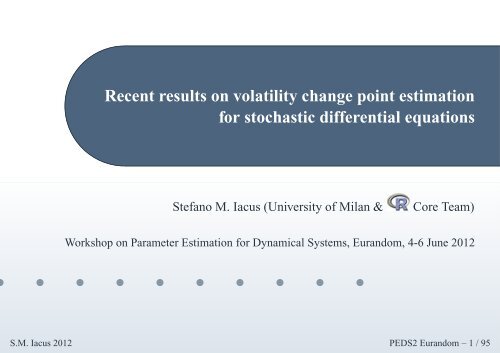
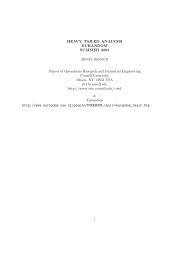
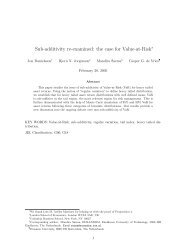
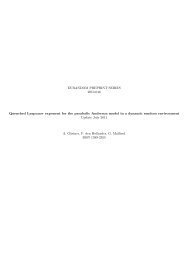
![The Contraction Method on C([0,1]) and Donsker's ... - Eurandom](https://img.yumpu.com/19554492/1/190x143/the-contraction-method-on-c01-and-donskers-eurandom.jpg?quality=85)
